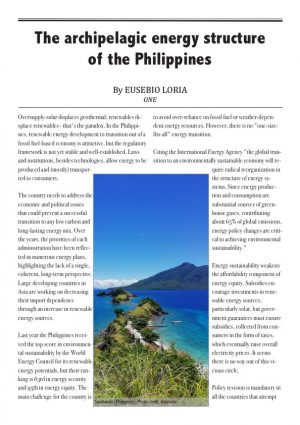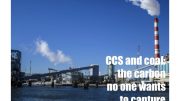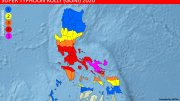 Oversupply-solar displaces geothermal; renewables displace renewables – that’s the paradox. In the Philippines, renewable energy development to transition out of a fossil fuel-based economy is attractive, but the regulatory framework is not yet stable and well-established. Laws and institutions, besides technologies, allow energy to be produced and (mostly) transported to consumers.
Oversupply-solar displaces geothermal; renewables displace renewables – that’s the paradox. In the Philippines, renewable energy development to transition out of a fossil fuel-based economy is attractive, but the regulatory framework is not yet stable and well-established. Laws and institutions, besides technologies, allow energy to be produced and (mostly) transported to consumers.
The country needs to address the economic and political issues that could prevent a successful transition to any low carbon and long-lasting energy mix. Over the years, the priorities of each administration have been reflected in numerous energy plans, highlighting the lack of a single, coherent, long-term perspective. Large developing countries in Asia are working on decreasing their import dependence through an increase in renewable energy sources.
Last year the Philippines received the top score in environmental sustainability by the World Energy Council for its renewable energy potentials, but their ranking is 63rd in energy security and 95th in energy equity. The main challenge for the country is to avoid over-reliance on fossil fuel or weather-dependent energy resources. However, there is no “one-size-fits-all” energy transition.
Citing the International Energy Agency “the global transition to an environmentally sustainable economy will require radical reorganization in the structure of energy systems. Since energy production and consumption are substantial sources of greenhouse gases, contributing about 65% of global emissions, energy policy changes are critical to achieving environmental sustainability.”
Energy sustainability weakens the affordability component of energy equity. Subsidies encourage investments in renewable energy sources, particularly solar, but government guarantees must ensure subsidies, collected from consumers in the form of taxes, which eventually raise overall electricity prices. It seems there is no way out of this vicious circle.
Policy revision is mandatory in all the countries that attempt energy transitions. Germany’s Energiewende includes a massive change in its nuclear strategy and the creation of an aggressive policy for renewable energy. China has begun shutting down its coal power plants and has heavily invested in solar, hydropower, and nuclear technologies. Each country selects its priority policy and works for it. On one side, the Philippine show fossil fuel dependence and, on the other side, high potential for renewables, despite no clear requirement by the law.
So, which is the most critical challenge for a rapidly growing nation on its way to a low-carbon future?
The social, political and economic factor
The Philippines are an archipelago of 7,641 islands in the Western Pacific Ocean, with a population of 104.9 million. The population grows at an average of 1.5 % per year, higher than the world average of 1.07 %. Despite being a lower-middle-income country, Philippines are one of the fastest-growing economies in Asia. Over the past six years, their economy grew by an average of 6.4%, with growth pace expected to continue at 6.5–6.7% in 2019. The Asian Development Bank expects the Philippines to become an upper-middle-income country by 2020.
To support the growing population and economy, the Philippine Department of Energy (DOE) expressed the need for total installed capacity addition of 43,765 megawatts (MW) by 2040. Currently, the Philippines’ installed capacity is 20,055 MW, of which 26% from renewable energy, 42.8% from coal, 7.4% from oil, and 24.2% from natural gas. Obviously, on the road of its energy transition, the Philippines aims to increase the share of renewables in its energy mix.
Climate framework
The Philippines are vulnerable to extreme weather events such as typhoons, floods, and rising sea levels. The Global Climate Risk Index 2017 ranks the Philippines as the world’s fifth-most affected country by extreme weather events and other natural hazards like earthquakes, even while global average temperature increase is still at +1 °C above preindustrial levels. Thus, the Philippines are forced to face climate change dilemmas.
Legislation
Unstable energy supplies in the late 1990s encouraged the government to liberalize its electricity sector with the Electric Power Industry Reform Act, which remains at the core of the national legal framework on energy. The 2008 law on renewable energy (called RE-Act, Renewable Energy Act) attempted to mitigate EPIRA, through the promotion of renewables.
The goals for the renewable energy sector included: increasing renewable energy capacity by 15 GW by 2030 (roughly 50% of total installed capacity); becoming the “number one” geothermal energy producer in the world (currently second); becoming the “number one” wind energy producer in South East Asia; and expanding the contribution of hydropower, biomass, solar and ocean energy by 131 MW.
Whereas EPIRA provided the general framework for the power industry, the RE Act provided the direction for the use of renewable resources. These two acts were supposed to complement each other. A weel structured energy mix needs to be diversified and should prioritize indigenous energy sources. Escaping from fossil fuels dependency requires a stable long-term energy plan to rationalize and diversify energy sources. It is thus the responsibility of the national government to stimulate low-carbon investment while balancing the needs for energy security, equity and sustainability.
Fuel mix
The higher the dependency is on a particular fuel, the more challenging it is to eliminate its dependence. Coal-fired power plants primarily serve the baseload demand of the Philippines. Around 68% of the country’s coal comes from abroad, and 95.80% of the import is from only one country: Indonesia. These figures highlight the exposure of the Philippines’ electricity prices to international market fluctuations. Renewables are attractive to the Philippines because they are indigenous and environmentally sustainable sources. Conventional renewables, such as geothermal and hydropower, are cheaper to generate than emerging renewables such as wind, solar, biomass, run-of-river hydro, and ocean. Also, conventional renewables can serve as baseload and, with hydropower, also as peak load.
Natural gas plants are used in the Philippines as baseload and mid merit plants because they have more flexibility than coal plants, which makes natural gas the best complement to address renewables’ intermittency. However, the price of natural gas is still subject to international market volatility and indigenous gas fields depletion. An oil-fired power plant is quicker than natural gas plants, but oil is the most expensive among the fossil fuels, and its price is extremely volatile because of international market fluctuations.
Promoting renewables
The RE-Act provides specific mechanisms to promote renewables and create a way out of fossil fuel dependency. Re-Act offers the option to purchase electricity from renewable energy sources; and the must-dispatch rule as a tool to allow all intermittent renewables to be dispatched immediately to the grid.
The must-dispatch rule is also the reason behind the grid instability, and therefore there is the continuing need for fossil fuels to address renewables’ intermittency. Hydropower and battery storage can not be the answer yet, as the former capacity is dependent on hydrologic conditions, while the latter has not reached the commercial-stage yet. Then there is also the paradox where renewables displace renewables, as in Negros Island where the oversupply of solar power has displaced geothermal power.
Instability and uncertainty
In 2014 the Department Of Energy focused on formulating an optimal energy mix for the energy sector. After the national elections in 2016, the new administration moved away from an optimal energy mix policy and instead focused attention on the need to meet the country’s capacity requirements, thus prioritizing energy security, regardless of technology and energy sources involved.
Renewables sources also face another peculiar local barrier. Many renewables areas in the country are in lands of indigenous peoples to whom the Philippine Constitution has granted exclusive rights. Any activity on the land needs the consent of all indigenous inhabitants. Thus, even if only one out of ten indigenous tribes refuses, no free consent certificate can be issued — a sensible policy that can backfire as it discourages many greenfield renewables generators from entering the complex Philippine market.
Technical challenges
Limited investment in renewables can be attributed even to the insufficiency of the grid infrastructure and difficulties to see rapid technological developments.
Grid infrastructure has to be enhanced. The Philippines have two main unitary grids: the Luzon-Visayas grid, and the Mindanao grid. Currently, there is supply in excess from solar power in Panay, Negros, and Cebu that cannot be dispatched to neighbouring areas because of the line capacity restrictions. A sign of the inadequacy of the current grid to accommodate the increasing energy supply. Considering the Philippines’ archipelagic nature, both the EPIRA and the RE-Act law have promoted off-grid solutions to address “energy isolation barriers” arising from the geographic and economic remoteness of these areas. Off-grid areas, numbering 238, are primarily served by bunker-fired diesel generators and are subsidized by on-grid customers.
The Philippines are the only country in Southeast Asia still waiting for a law on energy efficiency and energy saving. It means there is no impulse for businesses to develop energy-efficient technologies. Reaching the Paris agreement commitments without it is impossible.
Eusebio Loria



